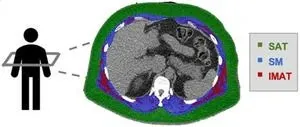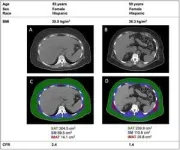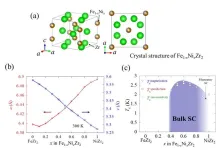(Press-News.org) People with pockets of fat hidden inside their muscles are at a higher risk of dying or being hospitalised from a heart attack or heart failure, regardless of their body mass index, according to research published in the European Heart Journal [1] today (Monday).
This ‘intermuscular’ fat is highly prized in beef steaks for cooking. However, little is known about this type of body fat in humans, and its impact on health. This is the first study to comprehensively investigate the effects of fatty muscles on heart disease.
The new finding adds evidence that existing measures, such as body mass index or waist circumference, are not adequate to evaluate the risk of heart disease accurately for all people.
The new study was led by Professor Viviany Taqueti, Director of the Cardiac Stress Laboratory at Brigham and Women's Hospital and Faculty at Harvard Medical School, Boston, USA. She said: “Obesity is now one of the biggest global threats to cardiovascular health, yet body mass index – our main metric for defining obesity and thresholds for intervention – remains a controversial and flawed marker of cardiovascular prognosis. This is especially true in women, where high body mass index may reflect more 'benign' types of fat.
“Intermuscular fat can be found in most muscles in the body, but the amount of fat can vary widely between different people. In our research, we analyse muscle and different types of fat to understand how body composition can influence the small blood vessels or ‘microcirculation’ of the heart, as well as future risk of heart failure, heart attack and death.”
The new research included 669 people who were being evaluated at the Brigham and Women’s Hospital for chest pain and/or shortness of breath and found to have no evidence of obstructive coronary artery disease (where the arteries that supply the heart are becoming dangerously clogged). These patients had an average age of 63. The majority (70%) were female and almost half (46%) were non-white.
All the patients were tested with cardiac positron emission tomography/computed tomography (PET/CT) scanning to assess how well their hearts were functioning. Researchers also used CT scans to analyse each patient’s body composition, measuring the amounts and location of fat and muscle in a section of their torso.
To quantify the amount of fat stored within muscles, researchers calculated the ratio of intermuscular fat to total muscle plus fat, a measurement they called the fatty muscle fraction.
Patients were followed up for around six years and researchers recorded whether any patients died or were hospitalised for a heart attack or heart failure.
Researchers found that people with higher amounts of fat stored in their muscles were more likely to have damage to the tiny blood vessels that serve the heart (coronary microvascular dysfunction or CMD), and they were more likely to go on to die or be hospitalised for heart disease. For every 1% increase in fatty muscle fraction, there was a 2% increase in the risk of CMD and a 7% increased risk of future serious heart disease, regardless of other known risk factors and body mass index.
People who had high levels of intermuscular fat and evidence of CMD were at an especially high risk of death, heart attack and heart failure. In contrast, people with higher amounts of lean muscle had a lower risk. Fat stored under the skin (subcutaneous fat) did not increase the risk.
Professor Taqueti said: “Compared to subcutaneous fat, fat stored in muscles may be contributing to inflammation and altered glucose metabolism leading to insulin resistance and metabolic syndrome. In turn, these chronic insults can cause damage to blood vessels, including those that supply the heart, and the heart muscle itself.
“Knowing that intermuscular fat raises the risk of heart disease gives us another way to identify people who are at high risk, regardless of their body mass index. These findings could be particularly important for understanding the heart health effects of fat and muscle-modifying incretin-based therapies, including the new class of glucagon-like peptide-1 receptor agonists.
“What we don’t know yet is how we can lower the risk for people with fatty muscles. For example, we don’t know how treatments such as new weight-loss therapies affect fat in the muscles relative to fat elsewhere in the body, lean tissue, and ultimately the heart.”
Professor Taqueti and her team are assessing the impact of treatments strategies including exercise, nutrition, weight-loss drugs or surgery, on body composition and metabolic heart disease.
In an accompanying editorial [2], Dr Ranil de Silva from Imperial College London and colleagues said: “Obesity is a public health priority. Epidemiologic studies clearly show that obesity is associated with increased cardiovascular risk, though this relationship is complex.
“In this issue of the Journal, Souza and colleagues hypothesize that skeletal muscle quantity and quality associate with CMD and modify its effect on development of future adverse cardiovascular events independent of body mass index (BMI).
“In this patient population who were predominantly female and had a high rate of obesity, the main findings were that increasing levels of intermuscular adipose tissue (IMAT) were associated with a greater occurrence of CMD, and that the presence of both elevated IMAT and CMD was associated with the highest rate of future adverse cardiovascular events, with this effect being independent of BMI.
“The interesting results provided by Souza et al are hypothesis generating and should be interpreted in the context of several limitations. This is a retrospective observational study. Whilst a number of potential mechanisms are suggested to explain the relationship between elevated IMAT and impaired coronary flow reserve, these were not directly evaluated. In particular, no details of circulating inflammatory biomarkers, insulin resistance, endothelial function, diet, skeletal muscle physiology, or exercise performance were given.
“The data presented by Souza et al are intriguing and importantly further highlight patients with CMD as a population of patients at increased clinical risk. Their work should stimulate further investigation into establishing the added value of markers of adiposity to conventional and emerging cardiac risk stratification in order to identify those patients who may benefit prognostically from targeted cardiometabolic interventions.”
END
Fatty muscles raise the risk of serious heart disease regardless of overall body weight
2025-01-20
ELSE PRESS RELEASES FROM THIS DATE:
HKU ecologists uncover significant ecological impact of hybrid grouper release through religious practices
2025-01-19
Ecologists from the School of Biological Sciences (SBS) and the Swire Institute of Marine Science (SWIMS) at The University of Hong Kong (HKU) have identified significant ecological risks associated with the release of hybrid groupers into Hong Kong’s coastal waters, a practice often linked to religious ‘mercy release’ rituals.
Their study highlights how the Tiger Grouper-Giant Grouper hybrid (TGGG), also known as the Sabah grouper, disrupts local marine ecosystems by exploiting unique ecological niches and potentially becoming a dominant predator. This research, the first ...
New register opens to crown Champion Trees across the U.S.
2025-01-18
The National Champion Tree Program (NCTP) announced its first Register of Champion Trees since 2021. The program moved from American Forests to the University of Tennessee School of Natural Resources in 2023 and has spent the past year working with state-level Champion Tree programs across the U.S. to update outdated records and verify the newly crowned champions.
“We are thrilled beyond measure to share the list of the largest documented trees in the United States,” Jaq Payne, NCTP director, said. “These trees are more than just numbers on a website. They're living, breathing members of our community. I hope this register encourages folks to start ...
A unified approach to health data exchange
2025-01-18
About The Article: This article outlines the ways in which the U.S. Department of Health and Human Services has worked to use electronic health record data to improve patient health, public health, and health care.
Corresponding Author: To contact the corresponding author, Robert M. Califf, MD, email commissioner@fda.hhs.gov.
To access the embargoed study: Visit our For The Media website at this link https://media.jamanetwork.com/
(doi:10.1001/jama.2025.0068)
Editor’s ...
New superconductor with hallmark of unconventional superconductivity discovered
2025-01-18
Tokyo, Japan – Researchers from Tokyo Metropolitan University have discovered a new superconducting material. They combined iron, nickel, and zirconium, to create a new transition metal zirconide with different ratios of iron to nickel. While both iron zirconide and nickel zirconide are not superconducting, the newly prepared mixtures are, exhibiting a “dome-shaped” phase diagram typical of so-called “unconventional superconductors,” a promising avenue for developing high temperature superconducting materials which can be more widely deployed in society.
Superconductors already play ...
Global HIV study finds that cardiovascular risk models underestimate for key populations
2025-01-18
Cardiovascular disease (CVD) is the leading cause of morbidity and mortality globally, posing a particularly significant threat to people with HIV (PWH). To address this, CVD prevention plans rely on prediction models like atherosclerotic cardiovascular disease (ASCVD) risk scores to estimate the risk of heart disease.
However, previous studies have called into question whether these commonly used prediction models perform well among people with HIV, and there remains a gap in understanding of what these scores mean for PWH in low- and middle-income countries (LMICs).
Researchers from Massachusetts General Hospital, a founding member of the Mass General Brigham ...
New study offers insights into how populations conform or go against the crowd
2025-01-17
Cultural traits — the information, beliefs, behaviors, customs, and practices that shape the character of a population — are influenced by conformity, the tendency to align with others, or anti-conformity, the choice to deliberately diverge. A new way to model this dynamic interplay could ultimately help explain societal phenomena like political polarization, cultural trends, and the spread of misinformation.
A study published in the Proceedings of the National Academy of Sciences outlines this novel approach. Presenting a mathematical model, SFI Complexity Postdoctoral Fellow Kaleda Denton with colleagues ...
Development of a high-performance AI device utilizing ion-controlled spin wave interference in magnetic materials
2025-01-17
A research team from NIMS and the Japan Fine Ceramics Center (JFCC) has developed a next-generation AI device—a hardware component for AI systems—that incorporates an iono-magnonic reservoir. This reservoir controls spin waves (collective excitations of electron spins in magnetic materials), ion dynamics and their interactions. The technology demonstrated significantly higher information processing performance than conventional physical reservoir computing devices, underscoring its potential to transform AI technologies.
As AI devices become increasingly sophisticated, ...
WashU researchers map individual brain dynamics
2025-01-17
By Shawn Ballard
The complexity of the human brain – 86 billion neurons strong with more than 100 trillion connections – enables abstract thinking, language acquisition, advanced reasoning and problem-solving, and the capacity for creativity and social interaction. Understanding how differences in brain signaling and dynamics produce unique cognition and behavior in individuals has long been a goal of neuroscience research, yet many phenomena remain unexplained.
A study from neuroscientists and ...
Technology for oxidizing atmospheric methane won’t help the climate
2025-01-17
As the atmosphere continues to fill with greenhouse gases from human activities, many proposals have surfaced to “geoengineer” climate-saving solutions, that is, alter the atmosphere at a global scale to either reduce the concentrations of carbon or mute its warming effect.
One recent proposal seeks to infuse the atmosphere with hydrogen peroxide, insisting that it would both oxidize methane (CH4), an extremely potent greenhouse gas while improving air quality.
Too good to be true?
University of Utah atmospheric scientists Alfred Mayhew and Jessica Haskins were skeptical, so they set out to test the claims behind this proposal. Their results, published on ...
US Department of Energy announces Early Career Research Program for FY 2025
2025-01-17
WASHINGTON, D.C. – Today, the U.S. Department of Energy (DOE) announced it is accepting applications for the 2025 DOE Office of Science Early Career Research Program to support the research of outstanding scientists early in their careers. The program will support over 80 early career researchers for five years at U.S. academic institutions, DOE national laboratories, and Office of Science user facilities.
“The vision, creativity, and effort of early career faculty drive innovation in the basic science enterprise. The Department of Energy’s Office of Science is dedicated to ...







